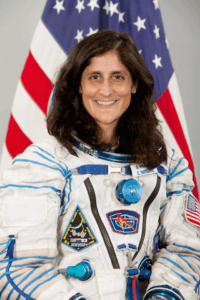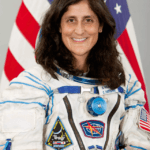
Who is Sunita L. Williams?
Sunita Lyn “Suni” Williams (born Sunita Pandya on September 19, 1965) is an esteemed American astronaut, a retired officer of the United States Navy, and currently holds the position of commander aboard the International Space Station (ISS). She is among the most seasoned spacewalkers, having conducted nine extravehicular activities (EVAs), the second highest for any female astronaut. Her cumulative EVA duration stands at 62 hours and 6 minutes, placing her fourth overall and the leading woman in total spacewalk hours. Williams has been part of several ISS missions, including Expeditions 14, 15, 32, and 33. In 2024, she embarked on the first crewed flight of Boeing’s Starliner spacecraft. Due to technical setbacks, her return to Earth has been postponed until March 16, 2025.
Early Years and Academic Background
Williams was born in Euclid, Ohio, but considers Needham, Massachusetts, as her hometown. Her father, Deepak Pandya, was an Indian-American neuroscientist from Gujarat’s Mehsana district, while her mother, Ursuline Bonnie Pandya (née Zalokar), was of Slovenian descent. Her parents settled in Falmouth, Massachusetts. She is the youngest of three siblings, with an elder brother, Jay Thomas, and a sister, Dina Annad.
Williams’ lineage is deeply rooted in Jhulasan, Mehsana, on her paternal side and Slovenian heritage from her maternal family. In honor of her cultural background, she carried a Slovenian flag, a samosa, and Carniolan sausage to space. Her nicknames include “Suni” in the United States and “Sončka” in Slovenia.
She completed her schooling at Needham High School in 1983 and went on to earn a Bachelor of Science degree in physical science from the United States Naval Academy in 1987. In 1995, she attained a Master of Science in engineering management from the Florida Institute of Technology.
Naval Service and Aviation Career
Williams received her commission as an ensign in the U.S. Navy in May 1987. Following a six-month temporary assignment at the Naval Coastal System Command, she obtained the designation of Basic Diving Officer. She then proceeded to the Naval Air Training Command, where she earned her wings as a Naval Aviator in July 1989.
Her early flight training included instruction on the H-46 Sea Knight in Helicopter Combat Support Squadron 3 (HC-3). She was later posted to Helicopter Combat Support Squadron 8 (HC-8) in Norfolk, Virginia, where she participated in overseas missions across the Mediterranean, Red Sea, and Persian Gulf as part of Operation Desert Shield and Operation Provide Comfort.
In 1992, she led an H-46 detachment aiding disaster relief efforts in Miami, Florida, following Hurricane Andrew. The following year, Williams commenced training at the U.S. Naval Test Pilot School, completing the program in December 1993. She was subsequently assigned to the Rotary Wing Aircraft Test Directorate as a project officer and V-22 chase pilot, where she tested a variety of aircraft, including the SH-60B/F, UH-1, AH-1W, SH-2, VH-3, CH-53, and H-57.
In 1995, Williams returned to the Naval Test Pilot School as an instructor, flying UH-60, OH-6, and OH-58 helicopters. She later served aboard USS Saipan as Aircraft Handler and Assistant Air Boss. During her deployment in June 1998, she was chosen for NASA’s astronaut training program. Over her military career, she logged more than 3,000 flight hours across 30 aircraft types. She retired from the U.S. Navy in 2017.
NASA Career and Space Missions
Astronaut Training and Initial Spaceflight
Williams began her astronaut training at NASA’s Johnson Space Center in August 1998.
STS-116 Mission and Expeditions 14 & 15
She first traveled to the ISS on December 9, 2006, aboard Space Shuttle Discovery during the STS-116 mission, joining the Expedition 14 team. In April 2007, with a crew rotation, she transitioned to Expedition 15.
During her time on the ISS, Williams arranged to donate her ponytail to the “Locks of Love” charity, with fellow astronaut Joan Higginbotham cutting her hair aboard the station. She undertook her first EVA on the eighth day of the STS-116 mission and completed three additional spacewalks alongside astronaut Michael López-Alegría.
Williams’ cumulative EVA time reached 29 hours and 17 minutes, surpassing Kathryn C. Thornton’s previous record for most spacewalking time by a female astronaut. However, in December 2007, Peggy Whitson surpassed her with a total EVA duration of 32 hours and 36 minutes.
Her return to Earth was aboard STS-117 in June 2007, following a 192-day mission in space. Due to adverse weather at Kennedy Space Center, she landed at Edwards Air Force Base in California.
First Marathon in Space
On April 16, 2007, Williams became the first astronaut to complete a marathon in space, participating in the Boston Marathon while aboard the ISS. She finished the run in 4 hours and 24 minutes, receiving encouragement from her fellow crew members.
Expeditions 32 & 33
She embarked on her second mission to the ISS on July 15, 2012, via Soyuz TMA-05M, alongside Japanese astronaut Akihiko Hoshide and Russian cosmonaut Yuri Malenchenko. Upon reaching the station, she joined Expedition 32 and later took command of Expedition 33 in September 2012, becoming only the second woman to hold this role.
During this mission, Williams also completed a space triathlon, coinciding with the Nautica Malibu Triathlon on Earth. Using the ISS’s treadmill and stationary bike, she simulated swimming exercises with resistance equipment, completing the race in 1 hour, 48 minutes, and 33 seconds.
She returned to Earth on November 19, 2012, landing in Kazakhstan due to procedural delays in landing operations.
Commercial Crew Program and Boeing Starliner
In 2015, Williams was selected as one of the astronauts for NASA’s Commercial Crew Program, training with Boeing and SpaceX. She was later assigned to Boeing’s Starliner-1 mission, its first operational ISS flight.
In 2024, she made history as the first female astronaut to pilot an orbital spacecraft flight test aboard the Boeing Starliner. Due to technical issues with the service module, her return to Earth has been rescheduled to March 2025. During this extended stay, she took command of the ISS in September 2024. By the time she returns, she will rank among the top 12 astronauts for total spaceflight duration.
Personal Life and Cultural Legacy
Williams has been married to Michael J. Williams, a federal marshal, for over two decades. The couple shares a passion for aviation. She previously owned a Jack Russell Terrier named Gorby, who appeared on National Geographic’s “Dog Whisperer” in 2010.
Williams practices Hinduism and carried sacred Hindu texts, including the Bhagavad Gita and Upanishads, to space. She has visited India multiple times, receiving the Sardar Vallabhbhai Patel Vishwa Pratibha Award.
In Slovenia, she has been honored for promoting science and technology, receiving a medal of merit from former Slovenian President Borut Pahor.
Honors and Awards
- Padma Bhushan (India, 2008)
- Defense Superior Service Medal
- Legion of Merit
- NASA Spaceflight Medal
- Golden Order for Merits (Slovenia, 2013)
- BBC’s 100 Women List (2024)
What was Sunita Williams famous for?
Sunita Williams is famous for being a NASA astronaut, a retired U.S. Navy officer, and a record-holding spacewalker. She has conducted nine spacewalks, spending a total of 62 hours and 6 minutes outside the ISS, making her the leading female astronaut in spacewalking hours. She was also the commander of ISS Expedition 33 and participated in NASA’s Commercial Crew Program with Boeing’s Starliner.
Who is currently stuck in space?
Sunita Williams and her crewmate Butch Wilmore are currently aboard the International Space Station after their Boeing Starliner mission faced technical delays. Their return to Earth, originally planned for 2024, has been postponed to March 16, 2025, due to issues with the spacecraft’s service module.
Why did NASA select Sunita Williams in June 1998?
NASA selected Sunita Williams as an astronaut in June 1998 due to her extensive aviation and test pilot experience in the U.S. Navy. She had logged over 3,000 flight hours across 30 aircraft types and had a strong background in engineering, making her an ideal candidate for space missions.
Why is Sunita Williams famous?

Sunita Williams is famous for her contributions to space exploration, her record-setting spacewalks, and her leadership aboard the ISS. She was also the second woman to command the ISS and participated in the first crewed flight of Boeing’s Starliner.
What is Sunita Williams eating?
As a vegetarian, Sunita Williams follows a plant-based diet in space. During her missions, she has eaten a variety of space-approved vegetarian meals, including tofu, lentils, rice, and dehydrated vegetables. She has also carried Indian snacks, such as samosas, to space.
Why is December 9, 2006, important for Sunita Williams?
December 9, 2006, marks the date Sunita Williams launched to space for the first time aboard Space Shuttle Discovery (STS-116). She joined Expedition 14 on the ISS and later transitioned to Expedition 15, spending 192 days in space during this mission.
Who is the second Indian woman astronaut?
Sunita Williams is often referred to as the second Indian-origin woman astronaut after Kalpana Chawla. Though she is an American citizen, she has Indian heritage through her father, Deepak Pandya, who was born in Gujarat, India.
Did Sunita Williams come back to Earth?
Sunita Williams has returned to Earth from her previous space missions in 2007 and 2012. However, as of 2025, she remains on the ISS due to delays in the Boeing Starliner mission, with her return expected in March 2025.
Why is Sunita Williams stuck in space?
Sunita Williams is currently delayed in space due to technical issues with the Boeing Starliner spacecraft. The mission, which was supposed to last a short duration, has been extended to March 2025 as engineers work on resolving spacecraft-related concerns.